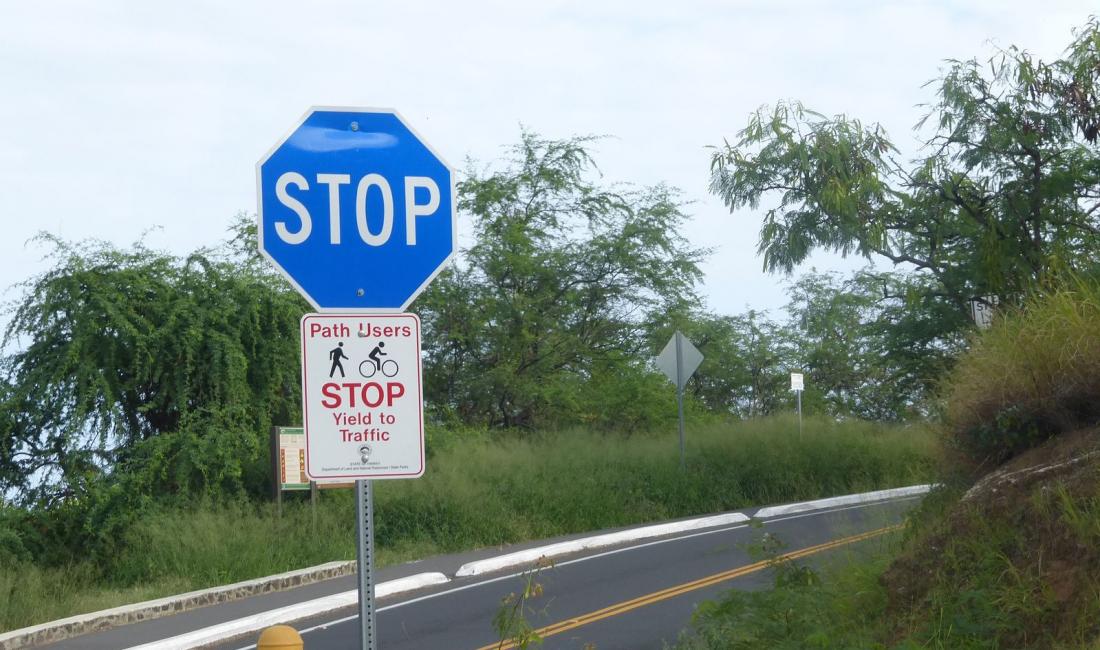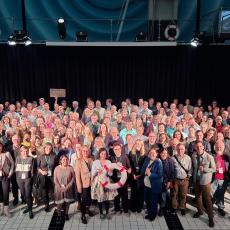Bill Fulton, a brilliant thinker on place and local governance, debuts a new Substack, "The Future of Where."
This piece is republished from The Future of Where, Bill Fulton's Substack. Photo credit: Wikimedia, Blue Stop sign in Hawaii. CC BY-SA 4.0
Ever since the beginning of the COVID pandemic in early 2020, we’ve had to constantly adjust our thinking about the role of where in our world. Throughout history, our entire society – culturally, socially, economically, even politically – has revolved around proximity. In order to get anything done, we had to be geographically or physically close to one another.
To make movies, you had to be in Hollywood. To make money, you had to be on Wall Street or in London or Tokyo. To get things done in politics, you had to be in Washington. To have access to a wide variety of job opportunities, you had to live close to a job center.
In other words, where mattered.
But since the COVID pandemic started in March of 2020, it seems like that whole premise has been turned upside down. Office-based workers don’t go to the office anymore – at least not very much. Most of them work at home at least part of the time. We shop online more than ever. Many of us feel like we spend most of our life on Zoom. Sometimes it seems like where doesn’t matter very much
But I don’t think it’s that simple. As an urban planner, journalist, former politician, and longtime observer of place, I think the reality is more complicated. If where doesn’t matter, then why have some locations – especially walkable ones – gotten bid up so much since the beginning of the pandemic? Why were we all so thrilled when the pandemic was over to go back to sports stadiums and music venues and restaurants beaches and shopping malls? It’s clear that where still matters – just in a different way than it used to.
So what is the future of where?
That’s what I’m going to try to explore in this Substack newsletter: In what ways do location, proximity, and place still matter to us? And how is the importance of where changing?
There is actually nothing new about this debate. It’s been with us for almost 200 years, ever since the invention of the telegraph – the precursor to the internet because it was the first device that allowed information to travel separately from – and faster than – people. Indeed, in the 1840s a lot folks predicted “the death of distance” and “the annihilation of time and space” because of the telegraph. Kind of like what people say now.
But weirdly, that didn’t happen. In part because of the telegraph, economic activity got more concentrated and cities got bigger. The telephone had a similar impact in the 20th Century. (I’ll write in more detail about the history of these precursors to the internet in a future Substack newsletter.)
Still, something seems different this time around.
For my entire working life, urban planners have been predicting a dramatic shift to remote work, at least for white-collar workers, in part because we hoped it would alleviate traffic congestion. (When I was an intern at the Southern California Association of Governments in the 1980s, a few of us dreamed up the idea out of whole cloth that telecommuting would account for 12% of commuting in the future, and that number remained in Los Angeles’s transportation plan for decades.) Yet until COVID, it never really happened.
Now it has. About 12% of all Americans worked remotely full-time in 2023, compared to 5% before the pandemic. About half of all Americans work a hybrid schedule. Dense job centers, formerly full of life and activity, are now desolate; office buildings are selling for a fraction of their pre-pandemic value and many observers fear an endless “urban doom loop” with activity and property values in cities spiraling ever-downward. Not surprisingly, since half of U.S. workers don’t have to go to the office every day, more of them are moving to the exurbs, according to the Census Bureau.
And yet … somehow or other the importance of where persists.
Most obviously, quality of place has become a luxury consumer item. Remote workers who can afford it have moved from large metropolitan areas to smaller “cute” cities in attractive natural settings – ranging from Hudson, N.Y., to Bend, Oregon – thus driving up the price of housing in those towns to unaffordable levels. (In Bend, perhaps the leading “Zoomtown” in the country, median home price went up 60% during the pandemic.) To these high-end consumers, where matters a great deal.
And despite all the hype about Austin and Miami drawing tech zillionaires away from California during the pandemic – and all the other problems the Bay Area has seen – almost 60% of all venture capital-backed startups in 2024 were based in California. (By contrast, 2% were based in Texas.) The old joke that the VCs want their investments to be located within a 20-minute drive of Sand Hill Road in Palo Alto is still more true than you might think. Where still matters in Silicon Valley as well.
Finally, both the pandemic and its aftermath have – at least in my opinion – left us wanting to be together more often. Entertainment and sports are maybe the best examples. I can remember when the Dodgers were the only major league team to draw 3 million fans (about 37,000 per game) – a number that astonished everyone. Last year, eight teams drew 3 million fans. Meanwhile, Taylor Swift’s concerts are so popular that they can alter the economy of an entire city. According to one estimate, her six concerts in Los Angeles recently created 3,300 jobs. And restaurant revenues have not just bounced back from the pandemic – they’re up 40% from the pre-pandemic high. (Some of that is rising food prices, but not all of it.)
In a way, the rise of Zoomtowns and the return of live sports, entertainment, and dining out after the pandemic are feeding the same basic human desire: The desire to be together. We used to gather in specific locations because we had to – we had to go to the office because that’s where our paper and our computer terminals were – and now we gather because we want to. In large part, then, the future of where is about getting together in specific locations to have fun.
Will We Still Get Together Because We Have To … Or Just Because We Want To?
The big unanswered question about the future of where is: to what extend will we still get together in the future because we have to. Yes, we’ll Zoom all the time with people even when we are in close proximity to them, both for business and personal reasons. (My homeowners association regularly holds meetings via Zoom even though we all live in the same building.) But will that replace the need to see each other in person – or will it increase the demand to see each other in person.
Already, in the post-pandemic world, we are beginning to appreciate what it’s like to be together in person, not just for personal reasons but professional ones as well. There’s nothing quite like meeting a person in person, shaking their hand, looking them in the eye. And even as we continue to Zoom most of the time from our spare bedroom (in what I call the “suburban workshop”), we’ll continue to have critical meetings in person at central locations (in what I call the “urban hotel”).
So place still matters, even after the pandemic. We might visit, use, and consume specific places more carefully and more intentionally than we used to – but clearly where still plays an important role in our lives. I look forward to sharing the future of where with you in the weeks and months ahead.



